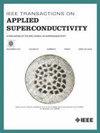Critical Current Performances of CICC Consisting of Two Different Arrangements of Quasi-Isotropic Strands
IF 1.7
3区 物理与天体物理
Q3 ENGINEERING, ELECTRICAL & ELECTRONIC
引用次数: 0
Abstract
The high current cable-in-conduit conductor (CICC) consisting of high-temperature superconducting (HTS) strands has great potential for application in high field magnets. Multiple strands can be arranged in various ways to form CICC, such as centrosymmetric and axisymmetric arrangements. In this paper, the critical current performances of CICC consisting of the two arrangements of strands are analyzed. Firstly, using the finite element method (FEM) and a self-consistent model, the critical current of CICC with two arrangements of quasi-isotropic strands (Q-IS) are numerically analyzed at 77, 20 and 4.2 K, in applied magnetic fields with different magnitudes and orientations, respectively. Meanwhile, parallel calculations are conducted on the critical current of CICC consisting of direct stacked conductor (DSC). Finally, the critical current of the CICC under different magnetic fields are measured by experiment in 77 K, which showed good consistency with the simulation results. The results indicate that using a centrosymmetric arrangement can achieve better critical current isotropy for CICC, and also show that the isotropy of using Q-ISs is better than that of DSCs, regardless of the arrangement. This paper provides a reference for the selection of strand type as well as arrangement for CICC production.求助全文
约1分钟内获得全文
求助全文
来源期刊

IEEE Transactions on Applied Superconductivity
工程技术-工程:电子与电气
CiteScore
3.50
自引率
33.30%
发文量
650
审稿时长
2.3 months
期刊介绍:
IEEE Transactions on Applied Superconductivity (TAS) contains articles on the applications of superconductivity and other relevant technology. Electronic applications include analog and digital circuits employing thin films and active devices such as Josephson junctions. Large scale applications include magnets for power applications such as motors and generators, for magnetic resonance, for accelerators, and cable applications such as power transmission.
 求助内容:
求助内容: 应助结果提醒方式:
应助结果提醒方式:


